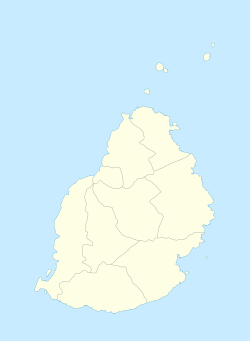Chamarel
| Chamarel | |
|---|---|
| Village | |
 Chamarel | |
| Coordinates: 20°25′30.34″S 57°23′30.07″E / 20.4250944°S 57.3916861°ECoordinates: 20°25′30.34″S 57°23′30.07″E / 20.4250944°S 57.3916861°E | |
| Country |
|
| Districts | Rivière Noire District |
| Government | |
| Population (2011)[1] | |
| • Total | 783 |
| • Density | 26.5/km2 (69/sq mi) |
| Time zone | MUT (UTC+4) |
| Area code(s) | 230 |
| ISO 3166 code | MU |
Chamarel is a village in Mauritius located in Rivière Noire District, the eastern part of the village also lies in the Savanne District. The village is administered by the Chamarel Village Council under the aegis of the Rivière Noire District Council.[2] The population is one of the lowest in Mauritius, according to the census made by Statistics Mauritius in 2011, the population was at 783.[1]

The village is named after the Frenchman Charles Antoine de Chazal de Chamarel, who lived in the area around 1800. Today it is primarily known for its scenic locations and nature attractions in its neighbourhood, among them are the Seven Coloured Earths, the Chamarel Falls and the Black River Gorges National Park. The surrounding area is also known for its locally grown coffee. Chamerel's church Saint Anna was built is 1876 and is subject to a pilgrimage on the Assumption of Mary (August 15), during which the village host a fair associated with the pilgrimage as well. [3][4][5]
See also
References
- ↑ 1.0 1.1 Table G1 - Resident population by geographical location, whereabouts on census night and sex. Statistics Mauritius. 2011. p. 3 and 4. Retrieved 19 December 2012.
- ↑ Ministry of Local Government and Outer Islands. Local Government Act 2011. Government of Mauritius. Retrieved 19 December 2012.
- ↑ Wolfgang Därr: Mauritius. DuMont Reiseverlag 2010, ISBN 978-3-7701-7688-5, p. 192 (German)
- ↑ Jean-Bernard Carillet, Brandon Presser: Mauritius Reunion & Seychelles. Lonely Planet 2010, ISBN 978-1-74179-167-9, pp. 108–110
- ↑ Rosabelle Boswell: Challenges to identifying and managing intangible cultural heritage in Mauritius, Zanzibar and Seychelles. African Book Collective 2008, ISBN 978-2-86978-215-0, p. 45-46
| Wikimedia Commons has media related to Chamarel. |